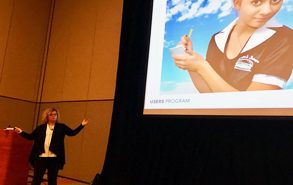Emma Warrillow, President of Data Insight Group, Inc., believes analysts add business value when they ask questions of the business, the data and the approach. “Don’t be an order taker,” she said.

Warrillow held to her promise that attendees wouldn’t see a stitch of SAS programming code in her session Monday, April 3, at SAS Global Forum.
Not that she doesn’t believe programming skills and SAS Certifications aren’t important. She does.
Why you need communication skills
But Warrillow believes that as technology takes on more of the heavy lifting from the analysis side, communication skills, interpretation skills and storytelling skills are quickly becoming the data analyst’s magic wand.
Warrillow likened it to the centuries-old question: If a tree falls in a forest, and no one is around to hear it, did it make a sound? “If you have a great analysis, but no one gets it or takes action, was it really a great analysis?” she asked.
If you have a great analysis, but no one gets it or takes action, was it really a great analysis? Click To TweetTo create real business value and be the unicorn – that rare breed of marketing technologist who understands both marketing and marketing technology – analysts have to understand the business and its goals and operations.
She offered several actionable tips to help make the transition, including:
1. Never just send the spreadsheet.
Or the PowerPoint or the email. “The recipient might ignore it, get frustrated or, worse yet, misinterpret it,” she said. “Instead, communicate what you’ve seen in the analysis.”
2. Be a POET.
Warrillow is a huge fan of the work of Laura Warren of Storylytics.ca. who recommends an acronym approach to data-based storytelling and making sure every presentation offers:
- Purpose: The purpose of this chart is to …
- Observation: To illustrate that …
- Explanation: What this means to us is …
- Take-away or Transition: As a next step, we recommend …
3. Brand your work.
“Many of us suffer from a lack of profile in our organizations,” she said. “Take a lesson from public relations and brand yourselves. Just make sure you’re a brand people can trust. Have checks and balances in place to make sure your data is accurate.”
4. Don’t be an order taker.
Be consultative and remember that you are the expert when it comes to knowing how to structure the campaign modeling. It can be tough in some organizations, Warrillow admitted, but asking some questions and offering suggestions can be a great way to begin.
5. Tell the truth.
“Storytelling can be associated with big, tall tales,” she said. “You have to have stories that are compelling but also have truth and resonance.” One of her best resources is The Four Truths of the Storyteller” by Peter Gruber, which first appeared in Harvard Business Review December 2007.
6. Go higher.
Knowledge and comprehension are important, “but we need to start moving further up the chain,” Warrillow said. She used Bloom’s Taxonomy to describe the importance of making data move at the speed of business – getting people to take action by moving into application, analysis, synthesis and evaluation phases.
7. Prepare for the future.
“Don’t become the person who says, ‘I’m this kind of analyst,’” she said. “We need to explore new environments, prepare ourselves with great skills. In the short term, we’re going to need more programming skills. Over time, however, we’re going to need interpretation, communication and storytelling skills.” She encouraged attendees to answer the SAS Global Forum challenge of becoming a #LifeLearner.
For more from Warrillow, read the post, That analyst is certifiable!

